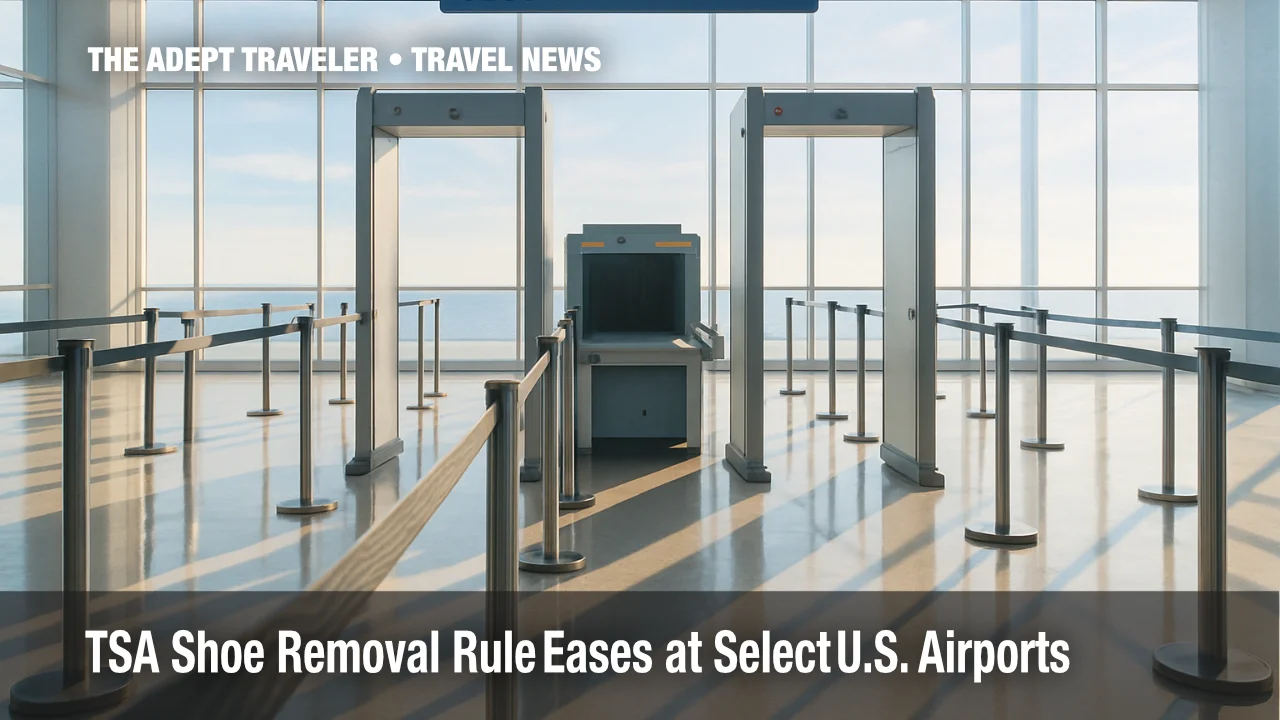TSA Shoe Removal Rule Eases at Select U.S. Airports

Flying through U.S. hubs could soon feel a little less like undressing in public. The Transportation Security Administration is piloting changes to the long-standing TSA shoe removal rule, allowing passengers at a handful of airports to keep their footwear on while clearing security. The test, announced in a July 7 press release, aims to shorten checkpoint lines, reduce exposure to dirty floors, and maintain explosives detection standards. If the agency likes the results, the perk could roll out nationwide within months. Here is what travelers should know right now.
Key Points
- Pilot lets most travelers keep shoes on at select airports
- Participating lanes use upgraded scanners and risk-based screening
- No signup or fee required, unlike PreCheck
- Why it matters: faster lines, fewer hygiene hassles, same security standards
- Nationwide expansion possible after data review in early 2026
TSA Shoe Removal Rule Snapshot - How It Works
Under the pilot, designated "stay-shod" lanes combine next-generation computed-tomography scanners with enhanced explosive trace detection. Passengers place carry-ons in the bins but keep shoes, light jackets, and belts on, similar to PreCheck. Officers receive real-time 3-D images that reveal hidden threats inside footwear without removal. Children under twelve and adults over seventy-five already enjoyed limited exemptions; the pilot extends convenience to the general population at the chosen sites. Signage directs travelers to the correct lanes, and officers may still request shoe removal for random checks or alarm resolution.
TSA Shoe Removal Rule Background - Why It Matters
Mandatory shoe checks date back to late 2001, when Richard Reid attempted to detonate explosives hidden in his sneakers on a Paris-to-Miami flight. After his foiled plot, the TSA required all passengers to remove shoes starting in 2006, citing a continuing threat from improvised footwear bombs. The policy briefly relaxed in 2011 for children and seniors, but most adults have shuffled through checkpoints barefoot for nearly two decades. Critics say the measure clogs lanes and offers marginal security value; defenders argue it remains a proven deterrent. By leveraging modern imaging and data-driven risk assessment, the agency hopes to preserve safety while giving travelers back a small piece of dignity.
TSA Shoe Removal Rule Latest Developments
The current pilot covers seven medium- and large-hub airports, including Atlanta (Hartsfield-Jackson), Denver, Miami, Boston-Logan, Seattle-Tacoma, San Antonio, and Indianapolis. The list may change as equipment rotates for maintenance, but the TSA website posts live updates before each travel day. Travelers do not need to register; officers simply wave them into the appropriate lane.
Pilot Goals and Timeline
During the three-month test, analysts will track average wait times, false-alarm rates, and passenger satisfaction scores. A minimum 15 percent reduction in queue time without a corresponding increase in threat alarms is the primary metric for success. Results will feed into a formal report due in January 2026, just ahead of the spring break surge.
Technology Behind the Change
The CT scanners in use can rotate shoes through multiple X-ray angles, creating a detailed volumetric map. Integrated AI looks for density signatures resembling known explosive compounds. If the algorithm flags an item, officers can zoom, slice, and even render a color-coded 3-D view to pinpoint the anomaly, then decide whether to request removal. The system is already standard in many European airports and in all U.S. PreCheck lanes.
Potential Nationwide Rollout
If the data confirm time savings and consistent detection, TSA leadership intends to fund additional scanners through the 2026 budget cycle. That could place stay-shod lanes in every Category X and Category I airport by late 2027. Smaller regional fields would follow as equipment ages out. The agency also hints that success here could pave the way for easing rules on light jackets and laptops. Until then, travelers should still arrive early, double-check what items can remain in bags, and heed officer instructions.
Analysis
For travelers, the upside is obvious: less juggling of bins, shorter lines, and cleaner socks. Business flyers who skip PreCheck to save money still gain a fast-lane-style perk. Families avoid the chaos of unlacing toddlers' sneakers. Airports benefit, too, because quicker throughput lets them delay costly checkpoint expansions. The policy underscores a broader shift from blanket rules toward risk-based screening that blends behavior analysis, data sharing, and smarter machines.
There are caveats. Flyers wearing steel-shanked boots or platform heels may still trip alarms. Travelers should keep footwear easy to inspect and free of hidden compartments. Also, do not toss those TSA-friendly socks just yet; airports not in the pilot will enforce the old rule. For more ways to breeze through security-including tips on permitted electronics and liquids-see our airport security guide.
Final Thoughts
The pilot proves the agency is willing to question old habits born of crisis. If results match expectations, the TSA shoe removal rule could join liquid limits and laptop checks on the list of annoying procedures finally refined by new tech. Until expansion is confirmed, pack slip-on shoes, monitor airport advisories, and stay flexible. A faster, cleaner checkpoint experience may soon become the norm across U.S. skies.
